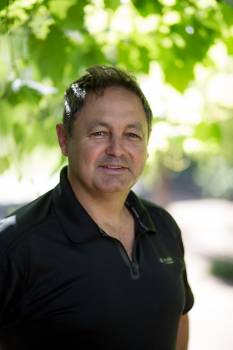Interview: Carl Schultz of Hartenberg
By Christian Eedes, 6 October 2014
From the October issue of Business Day WANTED: Now 49, Carl Schultz celebrated 20 years at renowned Stellenbosch farm Hartenberg last year and wears the mantle of “elder statesman” well. He is probably best known for his Shiraz – he makes no fewer than four versions of this variety – but his other wines are all more than proficient and it should not be forgotten that he won the title of Diners Club Winemaker of the Year in 2005 when the category was Merlot.
He is married to Cairn, a social work who is responsible for the farm’s after-school programmea nd women’s club. They have two children Michelle, aged 18, and Mark, 14, and they live on the property. “I get to walk to work and back daily,” says Schultz.
Where does Tenacity Merlot 2007 fit in the Hartenberg range?
The Cape Winemakers Guild allows for the submission of two possible auction wines every year. To ensure that Hartenberg has the best possible wine on sale annually, we put together three to four different bottlings and then do intensive internal tastings. The wines that show best get submitted for auction while the only slightly lesser remaining wines end up under the Tenacity label.
Tell us a bit more about the wine.
A lot of extra effort is employed in the vineyards especially at the onset of flavor development in the green berries. Merlot along with its Bordeaux cousins can tend to green, leafy, unripe aromatics and taste and one way of inhibiting this is exposure of the bunches to dappled light.
We also avoid cold soaking with Merlot as this increases the levels of metoxypyrazine [the flavour compound responsible for green flavours]. Fermentation is warm and rapid, again done in order to blow off pyrazines and we also know that use of new wood has positive effects re masking green aromatics, so the wine is introduced to barrel at an early stage.
Why’s Merlot so difficult to do well in South Africa?
There’s this genetic tendency to green characters, even at elevated alcohols, if the vineyard canopies are too dense. It’s also prone to over-cropping which produces thin wines and lastly the variety does not cope well in warmer appellations being subject to water stress.
Merlot on its own often disappoints and yet it seems to work well when blended with Cabernet Sauvignon. Why do you think this is?
Merlot is usually a lesser partner in most Bordeaux-style blends, which is to say between 5 to 40% only. As such, winemakers can then afford to pick Merlot at higher levels of ripeness – and higher potential alcohol – knowing that the other components of the blend will even things out.
You started at Hartenberg in 1994. What do you know now that you wish you knew then? Probably most importantly the now common knowledge regarding physiological ripeness and the techniques to suppress or mask “green” character.
What has been your most memorable wine experience?
In 1994, tasting 21 vintages with now deceased Philipe Jaboulet of their iconic La Chapelle, including the famed 1961 vintage.
You’re into whitewater kayaking. What’s the appeal?
It’s a rush. It’s physically demanding and requires your undivided attention. And you get to spend time in some really beautiful and remote places.
Beautiful places make for beautiful people, which is to say I have found that people who appreciate and respect nature and all its creatures are generally well grounded and balanced. The guys I started kayaking with some 25 years ago are also of my very best friends. The camaraderie and reliance on each other, found in other sports, rings true here. too.
Witte River, Bainskloof Pass is a favourite kayaking spot. What makes it special?
The river drops at 50m per kilometer, meaning steep ,fast-flowing rapids – the steepest in South Africa. It is rated a possible 5 out of 6 on the international scale of river difficulty which equates to “possible life-threatening conditions”.
You describe a siphon is a “kayaker’s nightmare”. Can you give us a simple definition?
A siphon is a natural hazard that occurs typically when the river enters a boulder-strewn section of river with drops. Large parts of the river get sucked down and in between the boulders, a bit like water leaving a bath when the plug has been pulled – your kayak potentially gets sucked onto the debris, and the flow doesn’t stop!
You say you took your biggest beating on the Futaleufu River in Chile. What happened?
It was 1995 and the “Fu” was the last of 18 rivers we had successfully kayaked in a three week period. Our group scouted the kilometer-long “Il Terminatore” rapid and tried to memorise the route down, threading truck-eating holes, siphons and hydraulics. My confidence up, I offered to act as “the probe”. Due to the flow speed I lost my line three-quarters of the way down, got eaten by a giant hole, spat out, popping my spray deck, filling my boat with water and dropping into an even bigger hole. After getting worked over for what felt like an eternity, I was ripped out of the kayakand sucked down, bouncing off the river floor. I surfaced only a full 200m downstream, sans kajak booties, and a lot more humble.









Comments
0 comment(s)
Please read our Comments Policy here.